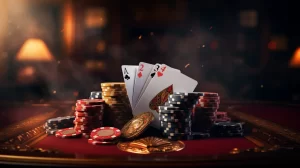The Art of Bluffing in Poker – Strategies and Techniques Revealed
3 min read
Bluffing in poker is an integral component of the game, yet not always profitable. To be effective at it, bluffing requires knowledge and intuition – players should study their opponents’ betting patterns as well as observe any other subtle signals they might provide.
Skilled players will know the optimal bluffing bet sizes by carefully considering equity and risk, taking into account current hand position and board situation.
Betting intervals
Action at a poker table often depends on the betting intervals used. While different games utilize different betting intervals, the overall process should remain similar: each player should announce how much they intend to bet before placing chips into the pool (pot) or pot (this process is known as “opening betting”) If they misstate or make errors when pushing chips into it – for instance not declaring enough as their bet – or push less chips than expected into it, this must be corrected verbally immediately otherwise they risk becoming all-in.
After each deal and betting interval, players may choose to bet a set amount into the pot (known as “pot”) so as to compete with other players and potentially win high-value hands. Unfortunately, if their funds don’t allow them to call bets from opponents with superior hands they will risk forfeiting all their chips; to prevent this prematurely exiting games early it is essential that additional chips be carried to call their bets from other superior hands and prevent loss.
Limits on bluffs
Bluffing is a central component of poker strategy. Unfortunately, newcomers often make costly errors when bluffing. For instance, they might use different bet sizings when betting bluffs than when wagering value hands – an obvious miscalculation that experienced opponents can exploit to their advantage.
A successful bluffer can also read other players’ bluffs. Their success depends on multiple factors, including their opponent’s tendencies and table image; for instance, bets placed against tight players will often succeed because their bets will be taken as signs of strength by opponents. Furthermore, number of callers will affect your bluffing strategy; bets against single callers tend to work better while multiple callers make your bluff less effective; you should also pay attention to betting history as this will influence size of bets placed by you throughout a hand or positional change by you or another player as it may change over time based on previous betting history as the size of bets placed should increase over time in response to changes within a hand progresses.
Detection strategies
Bluffing is an integral component of poker, enabling players to influence opponents’ decision-making and take control of the game by manipulating their decision making processes. But players must remember that bluffing can be risky and must balance strategy with psychology when engaging in tournament play; especially where stakes and pressure levels are greater.
Detection strategies can assist players in recognizing whether someone is bluffing. For instance, when players appear tense and stiff it may indicate they hold strong cards while relaxed players moving about may indicate they are trying to hide weak hands.
Other factors that can influence a player’s bluffing behavior include gender, experience and context. Women typically bluff less frequently than men while emotions and betting patterns also impact decision-making process when it comes to bluffing decision making – using effective bluffing strategies can make all the difference for a hand’s outcome!
Bluffing in tournaments
Bluffing is a key component of poker. It enables you to win pots when your hand is weak, or make your opponent believe you have one that is strong – something especially effective in No Limit where a weak preflop hand could potentially transform into something quite potent by the river. In order to bluff successfully, however, you need to know your opponents well and use bet sizes appropriate to them.
Once again, it’s important to keep in mind that your opponent might detect when you are trying to bluff, so be wary not to give away any clues that would indicate this intent – such as body language or betting history of player. Furthermore, any failed bluff is part of the game and shouldn’t be taken personally; rather, use its experience to refine your bluffing strategy for future use so as to become a more efficient player overall.




